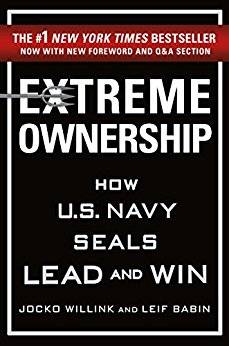

This article is an excerpt from the Shortform summary of "Extreme Ownership" by Jocko Willink and Leif Babin. Shortform has the world's best summaries of books you should be reading.
Like this article? Sign up for a free trial here .
While many leadership books and training courses focus on developing individual habits and traits, leadership is inextricably tied to the team’s performance. There are only two types of leaders — effective and ineffective — and the only way to measure a leader’s effectiveness is based on whether her team succeeds or fails.
As the person at the top of the chain of command, everything ultimately reflects back on you. You must make decisions quickly and definitively, and accept their consequences, good or bad. As a leader, you determine the team’s performance. This gives rise to the phrase, “no bad teams, only bad leaders.”
No Bad Teams, Only Bad Leaders
A leader is responsible for maintaining and enforcing high standards of performance as her team works toward its goals. The leader must not only dictate high standards, but refuse to tolerate anything less, because if poor performance is accepted without consequence, that becomes the new standard. If a team or team member completes a task that is not up to par, the leader needs to insist that task be re-done until it meets the standard.
Initial consequences for poor performance don’t need to be extreme. But if the problem is consistent and unaffected by efforts to correct it, then a leader needs to take more serious action. If a particular team member consistently performs poorly — despite the leader’s efforts to mentor and help her improve — and is holding the team back from its potential success, the leader must remove her from the team as a means to maintain high standards. Allowing her to stay means implicitly accepting her substandard performance, which indicates to the rest of the team that this is acceptable.
A leader should always be looking for ways to improve, and inspire her team to adopt the same mindset. As a leader, you can consistently raise the bar by objectively assessing your team’s and your own performance. You need to practice Extreme Ownership in order to take stock in this way, with brutal honesty and humility. When your recognize areas of weakness, develop a plan to improve them; similarly, you should recognize how individual team members can best contribute to the goal, and help everyone work together in a way that maximizes each person’s strengths to best achieve that goal.
An effective leader keeps her teams consistently focused on the next immediate, actionable goal, while she has the big-picture goal in mind. The larger goal can be daunting or too abstract for team members to grasp, so the leader must push and direct her team toward each individual goal along the way.
When an effective leader establishes a culture of Extreme Ownership throughout her team, the team can continue to perform well even in the leader’s temporary absence. Each junior leader — operating with the same mindset of Extreme Ownership — should be prepared and confident to step up in her leader’s absence to continue the team’s progress toward achieving its goal.
All of this is why there are no bad teams, only bad leaders. The leader makes the critical difference in the performance of the team.
Battle Story: The Leader Sets the Tone
It’s Hell Week in SEAL training, and the students are being pushed to their limits; they are physically and mentally exhausted.
The trainees are split into seven-person teams called boat crews that work together to carry the 200-plus pound inflatable rubber boats through obstacle courses, across the beach, and into the Pacific Ocean to paddle in seemingly endless races. For the races, each group’s designated boat crew leader receives orders from the training instructors, relays the instructions to the rest of his crew, and leads his team in a race against the other boat crews to be the first to correctly carry out the mission. The winning crew gets to sit out the following race, earning a few minutes of precious rest, while the crew in last place has to endure extra exercises as punishment.
The boat crew leaders have several responsibilities resting on their shoulders.
- Receive and understand instructors’ specific directions for each race, a task more difficult in their state of exhaustion
- Accurately and effectively relay the directions to their teams
- Lead and direct their teams to carry out the mission
- Face extra scrutiny from instructors for their crews’ shortcomings
During this particular Hell Week, two boat crews stand out: one is excelling, and the other is struggling.
Boat Crew II performs well and wins often. The crew’s leader is effective, and the crew members are all motivated and competent. The team members all work together and make up for each other’s weaknesses.
Boat Crew VI ends just about every race in last place. The team members yell and curse at each other, complain, and fail to work together. Boat Crew VI’s leader seems to think he simply has the bad luck of getting stuck with a bad team, and that their poor performance is beyond his control.
One of the training officers decides to switch the leaders for boat crews II and VI to see how it impacts each team’s performance. In the first race with the swapped leaders, Boat Crew VI actually wins; the leader gets them to work together as a team. And Boat Crew II still performs well, coming in second place.
Boat Crew VI continues to win races, and their disorganization and failure to work together is transformed, under their new leader, to smooth teamwork.
Boat Crew II also continues to do well, in spite of their new leader, because the crew members already know how to work together. Their previous leader established a culture of teamwork that they are able to maintain in his absence.
The experiment suggests that the leader is the biggest predictor of any team’s success.

———End of Preview———
Like what you just read? Read the rest of the world's best summary of "Extreme Ownership" at Shortform . Learn the book's critical concepts in 20 minutes or less .
Here's what you'll find in our full Extreme Ownership summary :
- What Extreme Ownership means, and why every responsible leader needs to get it
- How to get your team working smoothly together
- How leadership principles from Navy SEAL teams work in everyday business and life






